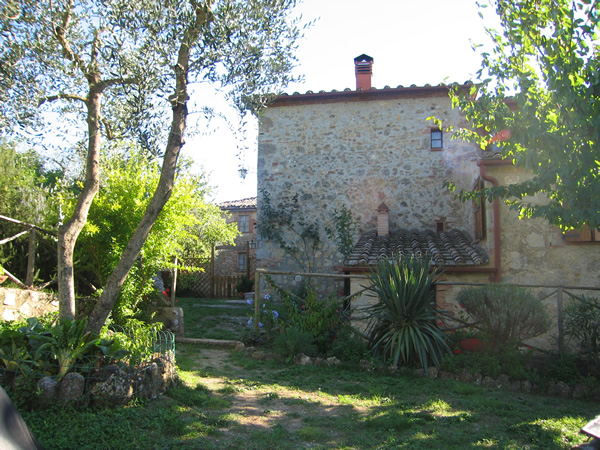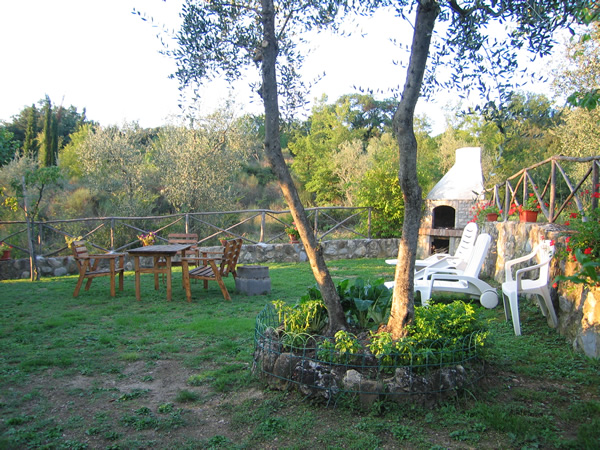Europe’s Rural B & Bs, Agriturismos
and Vacation Home Rentals
Find Your Best Home Base for Back
Door Travel
By Rick Steves

A rustic agriturismo in Murlo, near Siena in Italy.
After a walk through the happy muck
of pigs and lambs of the Gori's form, we sit down with Signora
Gori and her family to a classic Tuscan table — a sense
of harmony, nothing fancy, and no hurry. Most of the food
has been produced at the farm with patience and care, in
keeping with Italy’s — and now the world’s — Slow
Food movement.
We sip good red wine, dip our bread
in extra virgin olive oil, and savor each slice of prosciutto.
Full and content, we enjoy playing at a backgammon board
that has provided after-dinner fun for 200 years in this
very room. Surrounded by musty family portraits, alongside
a few guns used in Italy's 19th-century fight for independence,
we raise our wine glasses to good living — Tuscan style.
Agriturismos in Italy, gîtes in
France, and Ferienwohnungen in Germany
offer the chance to step away from the intensity of city
life and into the earthy elegance of the countryside. These
rural B & Bs — typically on working farms — provide
a great home base, ideal for couples or families traveling
by car.
Some agriturismos are simple and rustic,
while others are downright luxurious, offering amenities
such as swimming pools and riding stables. The quality of
the rooms varies, but they are always clean and comfortable.
Most places serve tasty homegrown food. Some are vegetarian
or organic. Others are gourmet. You may sit down at the
table with your host family or cook up your own dinner in
your kitchenette. You’ll find agriturismos that offer
cooking classes or horseback riding lessons and those that
simply set you free on the surrounding hiking trails. It’s
up to you to sort out how much action you want and to find
the place that suits your style.

View outside the agriturismo in Murlo.
Choosing the Right Spots
How do you find the right spots? The
same way you’d find a good rental in the U.S. Ask friends,
look through guidebooks, check out newspaper real estate
listings, and surf the Web (see listings below). Before
you look, identify what you hope to experience and where
you want to go.
Fortunately for Americans, the British
are some of the most avid seekers of rental property in
Europe. That means most places show up in English-language
catalogs and Web listings. Of course, if you speak another
language you can find more alternatives to the sites targeting
big-buck North Americans.
Keep in mind that Europeans, who have
more experience with weekly rentals than most American travelers,
often reserve their favorite place a year in advance. Still,
Europe is full of rental opportunities. With a little work
you can find one that’s right for you.
Listings on the Web typically fall into
three categories: catalog listings from established rental
agencies, local or regional listings from cooperating property
owners, and individual owners listing single properties.
Each source has merits. Established agencies often offer
more choices. They check out the properties and provide
ratings and reviews and often allow easier payment options
such as credit cards. But if you deal directly with the
owners you’ll probably pay less.
Generally, Web listings don’t fully
disclose the exact location of the property; you’ll
get that after you pay. Keep in mind these Web sites are
marketing vehicles for the listings. What looks secluded
or grand in a photo may actually be next to the local garage.
If you have doubts or questions you can usually resolve
them via email.
10 Tips for a Successful Rental
More than anything, you need to be flexible
and independent. Once you’ve checked in, that may be
the last you see of the owners. Of course emergency contacts
are always available.
1. Avoid peak season to sleep
cheap. Rental prices follow the old rule
of supply and demand. You’ll pay more to visit
popular vacation regions when the Europeans take their
holidays in July and August. For instance, a Tuscan
farmhouse that rents for as much as $1,900 a week
at peak times can go for as little as $600 in late
September or October.
2. If you want amenities,
be willing to pay for them. A private pool
can add substantially to the cost. Consider when you’ll
be going and whether you’ll use it — at the
height of summer, a pool may be worth every extra
euro.
3. Rural apartments can be
an excellent lower-cost option. Often the
owners have renovated an original rambling farmhouse
or medieval estate into a series of well-constructed
apartments with private kitchens, bathrooms, living
areas, and individual outdoor terraces. For one or
two people, these can cost less than an entire villa
or farmhouse. They usually share a common pool and
other amenities.
4. Most properties rent on
a traditional Saturday to Saturday time period. You
will probably be unable to rent for a different or
shorter time, especially during peak seasons.
5. You will need private
transportation, such as a rental car, to
fully enjoy — or even reach — a rural rental
property.
6. Go with the property owner’s
suggestions. The rental property usually
comes with an "instruction manual" containing
information on how to operate the appliances and suggestions
for local restaurants, shops, and sightseeing. Discover
authentic eateries and activities you might never
stumble upon otherwise.
7. Shop at local mom-and-pop
grocery stores. Once you get to know your
grocer, he’ll treat you like a local — personally
selecting the ripest fruit and freshest salad fixings.
Part of the fun is collecting all the goodies; the
other part is creating meals with them in your fully-equipped
kitchen.
8. Explore your neighborhood. An
early-morning walk as the sun rises will probably find
you in the company of the farmer as he trims his grape
vines, or the neighboring Italian grandmother tending
her small garden. Go ahead — interact, even if you
don’t really speak the language.
9. Start planning your next
visit before you return home. Explore rental
properties you notice, visit real estate agencies,
and ask local residents and ex-pats for recommendations.
10. Slow down and enjoy. One
of the joys of staying for at least a week in one location
is you can develop a true dolce far niente (sweetness
of doing nothing) attitude. If the rain is pattering
outside, grab a book from the in-house library and curl
up on the sofa. While your time in the countryside may
not be action-packed, staying put in one spot leaves
you open to the unexpected pleasures that come when you
just let the days unwind without a plan.
Thanks to Rick Garman for his help with
this article.
Rick Steves writes European travel guidebooks and hosts travel shows on public television and radio. His 50-plus books on European travel are available at bookstores and at www.ricksteves.com.
|
